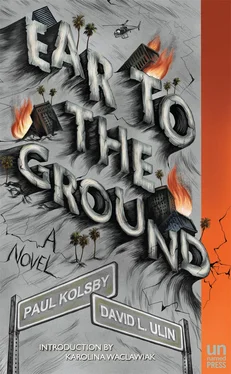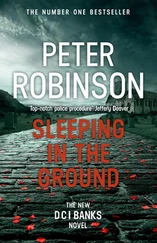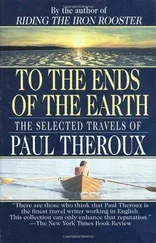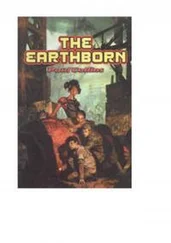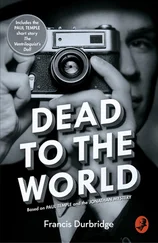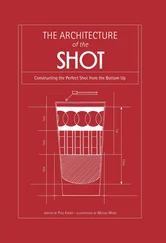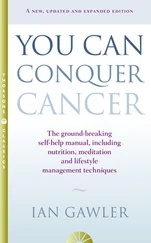Charlie had been startled. Leaning against a mound of dirt precisely at position D-55 of the San Andreas Fault, and wiping from his hand some mayonnaise from a chicken sandwich, he was working out a simple algorithm. Then suddenly, in the thick of his data, he came upon a curious block of prime numbers — which wasn’t alarming per se, but their proliferation did give him pause, which, in turn, brought him focus. Prime numbers were strange: divisible only by themselves and by the number one, they were anomalies, set off, unrelated. They reminded Charlie of a young boy poring over his butterflies while the other kids were out playing in the street. And here was a veritable convention of butterfly collectors, a group of misfit integers, crying for attention.
After looking at the numbers some more, he took a long swig of water and recapped his bottle, thinking. Fault lines may be important, but plate tectonic s were the Primary Disturbance Forces in the area. And Charlie understood plates. In the mid-1980s a man named Locksley had made brave statements about them, and had been run out of American seismology on a rail. But Locksley had missed an integral piece of the puzzle, and in his passion for plates he’d overlooked fault lines entirely.
Fault lines were important, Charlie knew, but only as conductors of the disturbances caused by the slippage of plates — not vice versa. This was where the Caltechies had gone wrong; it explained why they’d never predicted an earthquake, and why, Charlie thought with a smirk, they’d never offered him a job. At that moment he felt relieved by the simplicity of his task: to locate which plates were slipping, and wait. This much he’d been doing for more than a year. All that was missing was the link between the plates and these prime numbers. He knew, and yet he didn’t know.
He studied the data a while longer, and his heart beat with increased fervor. He packed up his gear, crammed it into the minuscule trunk of his forest green Miata, and shook his head. (The dealer had told him it was big enough to hold a set of golf clubs. He hadn’t considered the bag .) As the sun began to set, Charlie drove through the desert with the top down, thinking how some would consider the view romantic. Yet, twisting and turning beneath purple skies, he felt suddenly alone.
In the chairman’s office at the Center for Earthquake Studies, Sterling Caruthers sat behind his desk in a high-back leather chair, swiveling left and right in jerky movements, and consulting a calendar. Today was the twenty-third of June, he noticed, and sometime before the end of the year, he vowed, his organization would predict a major earthquake. His boys were close. That Kenwood — morose as he was — could program a computer to buy a beer and piss for you; and then there was Charlie Richter. The wild card. Caruthers didn’t like the guy but he knew he was a brilliant scientist, and wondered how long before Richter would do in L.A. what he’d done in Kobe.
Not that Caruthers particularly gave a shit about science; it might as well have been stocks and bonds, or real estate. But he’d found another land of opportunity — the land of earthquakes. Leaning back, he considered the advantages of knowing when and where a quake would hit. The possibilities were endless. He smiled, glanced at his hairy knuckles, and — stretching fingertips up —examined his nails. Then he unzipped a small leather case, extracted some silver-plated tools, and began to give himself a manicure.
CHARLIE’S EYES SNAPPED OPEN IN THE DARKNESS LIKE window shades. The digital clock screamed out the time in bright broken red. Twelve twenty-nine. One, two, twenty-nine. Prime numbers again. Maybe if he just closed his eyes, everything would be there, waiting for him. But when he tried, there were only grainy little patches of black.
Damn, he thought. He was so close; he could feel the connections struggling to be made. It was like the slow slipping of tectonic plates as they made their inevitable journeys apart. That was still what captivated Charlie most about seismology: the way the earth seemed so solid on the surface, yet was in a constant state of flux. Just the other day, walking from his Miata to the Versateller machine near the La Brea Tar Pits, he’d looked at the tall buildings lining Wilshire Boulevard, and thought how illusory they were, monuments to stability on a planet where the only constant was change. They were like prayers, these buildings, like gestures of faith in some kind of permanence that no one really believed, but which they counted on just the same. This was the bedrock principle all Angelenos shared, the hope that the city would hold together, and life on the fault line could be more than an extended waiting game.
Charlie got out of bed and walked naked through his darkened apartment. Something in his mind flashed like a strobe, the hall and the interior stairway appearing in flickers of shadow and light. Downstairs, he glanced towards the corner, where a seismograph traced a line so straight the earth itself appeared dead. Then, he sat at his computer console and listened to the humming of the machines, which gave him a delicious tickle in the pit of his stomach and along the surface of his scrotum.
“Okay,” he said to himself, barely aware that he had spoken. “Let’s see what we have.” He tapped a key, and two parallel columns of numbers scrolled across the screen. On another console, he accessed CES, and brought up a map of the western United States. He punched in a few coordinates, and a handful of red markers appeared.
Charlie heard the window rattle, and reached out to steady himself. Was that another one? Ever since Sunday night, when he’d been awakened by a cluster of temblors — a 4.9 and a couple of mid-3s — Charlie had been waiting. Publicly, he’d gone along with the idea that these were just aftershocks, but inside, he knew they were something more. Aftershocks were a fiction, a myth to soothe the worries of non-scientific minds. Earthquakes were connected, that much was true, but the connections were bigger than anyone at CalTech, or CES for that matter, was willing to admit. Charlie looked over at the seismograph. The needle remained still, but he couldn’t shake the feeling that something had happened, or was about to happen. Without thinking, he got up and headed for the back door.
Ian was reading next to a sleeping Grace when he heard the squeak of door springs downstairs. Quietly, gently, so as not to disturb her, he eased his naked body off the bed and crept to the window. For a moment, it was difficult to see the yard. Then, Ian made out a figure bent over the base of one of those metal poles. Charlie, he thought, and looked at the clock. It was one twenty-three. How weird.
But things got even weirder when Charlie stood up and caught the light. He was naked, too, crossing the yard without a stitch of clothing. Ian thought about waking Grace, but immediately decided against it. Instead, he dropped into a crouch by the window, and watched his neighbor make his way among the poles like a celebrant in some arcane religious rite.
Charlie was unsettled just then. There was still something he was missing, some information his machines couldn’t provide. He considered going back to the numbers, but he knew they weren’t enough.
All of a sudden it came to him. The soil samples. He had collected dirt from seven local faults, and the analysis reports were sitting in the Prediction Lab. It might be late, but he’d never fall back asleep, so he went inside, threw on some clothes, and zoomed off to CES.
The Center for Earthquake Studies was hulking and dark, and Charlie moved through it like a ghost. In the Prediction Lab, he began to pore over the soil analysis charts, checking them against the wall map.
Читать дальше
